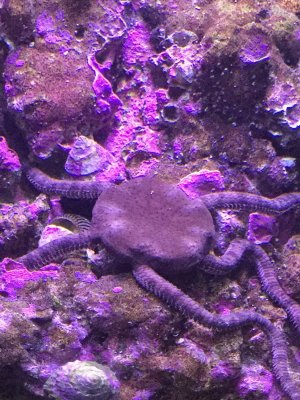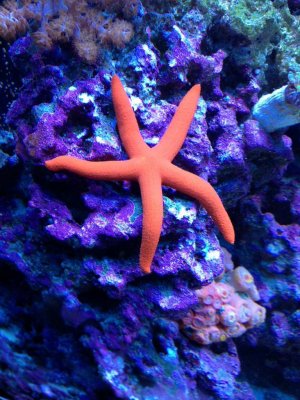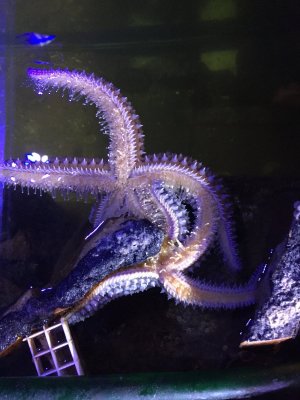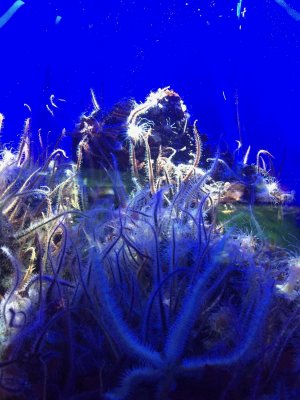Starfish or sea stars / Why starfish are cool
Most people know what a typical starfish looks like, and that they live in the sea and that they are kind of cute. But that’s it. In this article I will try to dig a little deeper into what kind of animals they are. We'll look at basic functions and cool super powers, and all the fun stuff that I find exciting about this group of animals. If you are looking for a husbandry protocol for starfish, this is not it. But it might be an eyeopener for a new interesting organism for your tank!
The star shape
The typical Sea Star or starfish has a central disc and five arms. There are species with many more arms. The record holder is the sunflower sea star with up to 24 arms. The upper side of the starfish is called aboral side and the lower side is called oral side. The upper surface might be hard with spikes, granular or smooth depending on species. Some of the specialized structures on the upper surface are the madreporite and the pedicillariae.
The madreporite is often visible as a spot or a button-like dot on the upper side of the central disc. This is the entrance of their water vascular system. The pedicillariae are very tiny claws, often on a stalk. Looking at these under a magnifying glass can be really cool. The functions of the pedicellariae are not fully known, but they can perhaps help cleaning the body of algae and other epiphytes (organism growing on another organism, in simple terms).
Can they see anything? Do they have any vision/sight?
Yes, they have eyes and they can see something. The eyes are located at the tip of each arm, and on some species these spots have a different color than the rest of the body. They are called ocelli or eye spots and are a type of rudimentary eye. They can detect light and see very low resolution images. Researchers have discovered recently that they use their sight to stay close to their homes. When their eyes were covered they couldn’t find their way back home even from just a meter away, which they can normally.
Does it have legs?
If you turn a sea star upside down you will see all their tube feet. There are thousands of them and they are like small movable tentacles with a suction cups at the top end. They use their feet to walk and cling onto surfaces. But they also use them to smell, for gas exchange, to collect food and to hunt.
The mouth is also located on the lower side right at the centre. The diet of sea stars varies a lot. They are mostly opportunists that will eat a lot of different foods. The diet can vary from algae to dead fish.
As an example the common sea star in Sweden, Asterias rubens, prefers blue mussels. To get a hold of the meat inside the mussel, the Sea Star grabs the shells with all its tube feet. Then they use their strength to pull apart the two shells. One millimeter is enough for the sea star to be able to get their stomach into the mussel and to start to eat. These types of starfish are able to evert a part of their stomach out through their mouth to start to digest the food outside their body.
Other starfish doesn’t have this type of stomach and have to bring the food into their mouths and to eat it whole. Inedible materials are ejected out through the mouth.
Another super power amongst the starfish is the ability to regenerate lost body parts. A pretty common sight is to see one individual with one arm shorter then the others. That’s probably an arm on its way to regrow. The regrowth can take a couple of months up to a year, so it’s not a quick process.
Some species are excellent at this talent and can regrow most of their bodies as long as there’s a certain amount of the central disc or an arm left. So you might just reproduce a sea star instead of killing it if you decide to cut them in half (like some fishermen did when they though there were too many sea stars in their fishing nets).
Fragmentation and the regeneration of body parts serves other purposes besides reproduction (yes, just like corals!) A Sea Star can release an arm if attacked by a predator. This way they can avoid being eaten by leaving a snack/limb for the hungry crab or lobster.
The starfish are invertebrates and do not have a skeleton like fish do. Instead they have a hydraulic system called a water vascular system. That water system gives the starfish the ability to move, cling onto surfaces, transport nutrients and to breathe. The water enters via the madreporite on the aboral side and the vascular systems extend throughout the whole body. The tube feet are connected to the water vascular system and also serves as sort of gills for gas exchange.

This diagram is courtesy of Megan I. McCuller & used with permission per Creative Commons License: CC BY-SA 4.0.
No brain right?
The star fish lack a central brain but have a complex nervous system. This system consist of a central ring around the mouth and extend throughout the arms, alongside the main canal of the water vascular system.
Sea star sex
Sea stars reproduce in lots of different ways, depending on species. It’s hard to tell the sex of most sea stars, especially the ones that are hermaphrodites. However, most species have separate male or female individuals. Some even start their lives as males and turn into females when they get older. And in a few species an adult female can release body parts that develop into male offspring. So this group is really all over the map when it comes to reproduction strategies.
External fertilization (free spawning) is most common, meaning they release their eggs and sperm into the water column and the fertilization happens there. The fertilized embryo then develops into a planktonic larvae. But some species lay eggs on rocks and some even sit on their eggs until they hatch.
Interesting for reef aquarists is the Archaster typicus way of reproduction, which looks a bit like hugging. They congregate when it’s time to spawn and a male finds a female and climbs on top of her. The male can stay on top of the female up to two months. During this time they synchronize their gamete activity so they can release their gametes at the same time. This is called pseudocopulation.
Relatives
The sea stars are echinoderms. In that phylum (or group), Echinodermata, you also find sea urchins, sea cucumbers, brittle stars and feather stars. The name Echinodermata is from ancient Greek and translates into ”hedgehog skin”. There are about 7000 living species today, and in most of them you can find the five-point radial symmetry. If you look closely on a sea urchin for example, you’ll often see five lines from the top to the bottom. Almost like you’ve made a ball out of a sea star. And you can also see the tube feet and pedicillariae on the urchin.
~~~~~~~~~
We encourage all our readers to join the Reef2Reef forum. It’s easy to register, free, and reefkeeping is much easier and more fun in a community of fellow aquarists. We pride ourselves on a warm and family-friendly forum where everyone is welcome. You will also find lots of contests and giveaways with our sponsors.
~~~~~~~~~~
Author Profile: @Sallstrom
David is a professional marine biologist at Sjöfartsmuseet Akvariet, or The Maritime Museum & Aquarium, in Gothenburg Sweden. He has a super interesting build thread covering his work at the museum, where he is the resident coral nerd. He has been keeping saltwater aquariums either at home or at work since 2001.
Most people know what a typical starfish looks like, and that they live in the sea and that they are kind of cute. But that’s it. In this article I will try to dig a little deeper into what kind of animals they are. We'll look at basic functions and cool super powers, and all the fun stuff that I find exciting about this group of animals. If you are looking for a husbandry protocol for starfish, this is not it. But it might be an eyeopener for a new interesting organism for your tank!
The star shape
The typical Sea Star or starfish has a central disc and five arms. There are species with many more arms. The record holder is the sunflower sea star with up to 24 arms. The upper side of the starfish is called aboral side and the lower side is called oral side. The upper surface might be hard with spikes, granular or smooth depending on species. Some of the specialized structures on the upper surface are the madreporite and the pedicillariae.
The madreporite is often visible as a spot or a button-like dot on the upper side of the central disc. This is the entrance of their water vascular system. The pedicillariae are very tiny claws, often on a stalk. Looking at these under a magnifying glass can be really cool. The functions of the pedicellariae are not fully known, but they can perhaps help cleaning the body of algae and other epiphytes (organism growing on another organism, in simple terms).
Can they see anything? Do they have any vision/sight?
Yes, they have eyes and they can see something. The eyes are located at the tip of each arm, and on some species these spots have a different color than the rest of the body. They are called ocelli or eye spots and are a type of rudimentary eye. They can detect light and see very low resolution images. Researchers have discovered recently that they use their sight to stay close to their homes. When their eyes were covered they couldn’t find their way back home even from just a meter away, which they can normally.
Does it have legs?
If you turn a sea star upside down you will see all their tube feet. There are thousands of them and they are like small movable tentacles with a suction cups at the top end. They use their feet to walk and cling onto surfaces. But they also use them to smell, for gas exchange, to collect food and to hunt.
Sea star tube feet attached to a blue mussel.

Photo is courtesy of @Sallstrom, ©2019 All Rights Reserved.
How does it eat?Photo is courtesy of @Sallstrom, ©2019 All Rights Reserved.
The mouth is also located on the lower side right at the centre. The diet of sea stars varies a lot. They are mostly opportunists that will eat a lot of different foods. The diet can vary from algae to dead fish.
As an example the common sea star in Sweden, Asterias rubens, prefers blue mussels. To get a hold of the meat inside the mussel, the Sea Star grabs the shells with all its tube feet. Then they use their strength to pull apart the two shells. One millimeter is enough for the sea star to be able to get their stomach into the mussel and to start to eat. These types of starfish are able to evert a part of their stomach out through their mouth to start to digest the food outside their body.
Other starfish doesn’t have this type of stomach and have to bring the food into their mouths and to eat it whole. Inedible materials are ejected out through the mouth.
The oral or lower side of a spiny sea star. Notice the stomach is partially visible through the mouth at the center.

Photo is courtesy of @Sallstrom, ©2019 All Rights Reserved.
Frag a sea star?Photo is courtesy of @Sallstrom, ©2019 All Rights Reserved.
Another super power amongst the starfish is the ability to regenerate lost body parts. A pretty common sight is to see one individual with one arm shorter then the others. That’s probably an arm on its way to regrow. The regrowth can take a couple of months up to a year, so it’s not a quick process.
Some species are excellent at this talent and can regrow most of their bodies as long as there’s a certain amount of the central disc or an arm left. So you might just reproduce a sea star instead of killing it if you decide to cut them in half (like some fishermen did when they though there were too many sea stars in their fishing nets).
Fragmentation and the regeneration of body parts serves other purposes besides reproduction (yes, just like corals!) A Sea Star can release an arm if attacked by a predator. This way they can avoid being eaten by leaving a snack/limb for the hungry crab or lobster.
Protoreaster linckii, Red Knob Seastar, thank you @Gareth elliott.

Photo is courtesy of @TriggerFinger, ©2019 All Rights Reserved.
So, no bones?Photo is courtesy of @TriggerFinger, ©2019 All Rights Reserved.
The starfish are invertebrates and do not have a skeleton like fish do. Instead they have a hydraulic system called a water vascular system. That water system gives the starfish the ability to move, cling onto surfaces, transport nutrients and to breathe. The water enters via the madreporite on the aboral side and the vascular systems extend throughout the whole body. The tube feet are connected to the water vascular system and also serves as sort of gills for gas exchange.
This diagram is courtesy of Megan I. McCuller & used with permission per Creative Commons License: CC BY-SA 4.0.
The star fish lack a central brain but have a complex nervous system. This system consist of a central ring around the mouth and extend throughout the arms, alongside the main canal of the water vascular system.
Sea star sex
Sea stars reproduce in lots of different ways, depending on species. It’s hard to tell the sex of most sea stars, especially the ones that are hermaphrodites. However, most species have separate male or female individuals. Some even start their lives as males and turn into females when they get older. And in a few species an adult female can release body parts that develop into male offspring. So this group is really all over the map when it comes to reproduction strategies.
External fertilization (free spawning) is most common, meaning they release their eggs and sperm into the water column and the fertilization happens there. The fertilized embryo then develops into a planktonic larvae. But some species lay eggs on rocks and some even sit on their eggs until they hatch.
Interesting for reef aquarists is the Archaster typicus way of reproduction, which looks a bit like hugging. They congregate when it’s time to spawn and a male finds a female and climbs on top of her. The male can stay on top of the female up to two months. During this time they synchronize their gamete activity so they can release their gametes at the same time. This is called pseudocopulation.
Relatives
The sea stars are echinoderms. In that phylum (or group), Echinodermata, you also find sea urchins, sea cucumbers, brittle stars and feather stars. The name Echinodermata is from ancient Greek and translates into ”hedgehog skin”. There are about 7000 living species today, and in most of them you can find the five-point radial symmetry. If you look closely on a sea urchin for example, you’ll often see five lines from the top to the bottom. Almost like you’ve made a ball out of a sea star. And you can also see the tube feet and pedicillariae on the urchin.
~~~~~~~~~
We encourage all our readers to join the Reef2Reef forum. It’s easy to register, free, and reefkeeping is much easier and more fun in a community of fellow aquarists. We pride ourselves on a warm and family-friendly forum where everyone is welcome. You will also find lots of contests and giveaways with our sponsors.
~~~~~~~~~~
Author Profile: @Sallstrom
David is a professional marine biologist at Sjöfartsmuseet Akvariet, or The Maritime Museum & Aquarium, in Gothenburg Sweden. He has a super interesting build thread covering his work at the museum, where he is the resident coral nerd. He has been keeping saltwater aquariums either at home or at work since 2001.
















